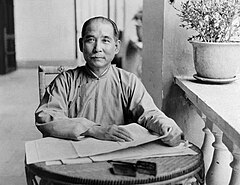Pan-Blue Coalition
Pan-Blue Coalition 泛藍聯盟 | |
|---|---|
Elections |
| Pan-Blue coalition | |
|---|---|
Hanyu Pinyin | Lán Yíng |
| Bopomofo | ㄌㄢˊ ㄧㄥˊ |
| Wade–Giles | Lan2 Ying2 |
| Tongyong Pinyin | Lán Yíng |
| IPA | [lǎn ǐŋ] |
| Southern Min | |
| Hokkien POJ | Lâm-iânn |
| Part of a series on |
| Conservatism in China |
|---|
 |
|
| Part of a series on |
| Three Principles of the People |
|---|
 |
|
The pan-Blue coalition, pan-Blue force or pan-Blue groups is a
Regarding the political status of Taiwan, this coalition maintains that the Republic of China instead of the People's Republic of China is the legitimate government of China, favors a Chinese and Taiwanese dual identity over an exclusive Taiwanese identity, and favors greater friendly exchange with Mainland China, as opposed to the Pan-Green Coalition.
Political stance
The Pan-Blue Coalition's political stance can be characterized as centre-right,[2] conservatism and Republic of China-centered Chinese nationalism.
Originally, the Pan-Blue Coalition was associated with Chinese unification, but has moved towards a more conservative position supporting the present status quo, while rejecting immediate unification with mainland China. It now argues that reunification is possible only after the communist regime in mainland China collapses or transitions to a democracy either as a new democratic government or with the re-establishment of Sun Yat-sen's Republic of China government which fled to Taiwan after the Chinese Civil War. This would also allow the body of Chiang Kai-shek to be returned to his ancestral home in Xikou.[citation needed]
History
Lee Teng-hui presidency: 1988–2000
Throughout the 1990s, the Kuomintang (KMT) consisted of an uneasy relationship between those party members who had mainland China backgrounds (came from mainland China in 1949) and Taiwanese political elites, Taiwanese factions led by President
During the
First time in opposition: 2000–2008
In the 2000 presidential election itself, the split in Kuomintang votes between Soong and Lien led in part to the election of Chen Shui-bian. After the election, there was widespread anger within the Kuomintang against Lee Teng-hui, who was expelled for forming his own pro-
The KMT and PFP ran a combined ticket in the
There were talks in late 2004 that the KMT and the PFP would merge into one party in 2005, but these talks have been put on hold. In the
However, after the
In the
Ma Ying-jeou presidency: 2008–2016
In the
Second time in opposition: 2016–present
In
Member parties
Current members
| Party | Ideology | Leader | |
|---|---|---|---|
| Kuomintang (KMT) | Conservatism | Eric Chu | |
| New Party (NP) | National conservatism | Wu Cherng-dean | |
| People First Party (PFP) | Liberal conservatism | James Soong | |
| Non-Partisan Solidarity Union (NPSU) | Conservative liberalism | Lin Pin-kuan | |
Legislative strength
Legislative Yuan
| Term | Member Party Seats | KMT Seats | NP Seats | PFP Seats | NPSU Seats | |
|---|---|---|---|---|---|---|
| 1st(1992) | 95 / 130
|
95 / 95
|
- | - | - | |
| 2nd | 95 / 162
|
95 / 95
|
- | - | - | |
| 3rd | 106 / 164
|
85 / 106
|
21 / 106
|
- | - | |
| 4th | 134 / 225
|
123 / 134
|
11 / 134
|
- | - | |
| 5th | 115 / 225
|
68 / 115
|
1 / 115
|
46 / 115
|
- | |
| 6th | 120 / 225
|
79 / 120
|
1 / 120
|
34 / 120
|
6 / 120
| |
| 7th | 85 / 113
|
81 / 85
|
- | 1 / 85
|
3 / 85
| |
| 8th | 69 / 113
|
64 / 69
|
- | 3 / 69
|
2 / 69
| |
| 9th | 39 / 113
|
35 / 39
|
- | 3 / 39
|
1 / 39
| |
| 10th | 40 / 113
|
40 / 40 [b]
|
- | - | - | |
| 11th | 54 / 113
|
54 / 54 [b]
|
- | - | - |
Media
See also
Explanatory notes
References
- ^ "九二共識普拉斯(上):國民黨內部曾提過「華獨」,為何最終沒有採用?". The News Lens (in Chinese). 27 April 2021. Retrieved 15 February 2024.
- ISBN 9781440850004.
The center-right Pan-Blue Coalition, led by the KMT, maintains that the ROC is the sole legitimate government for all of China (including Taiwan) and that the aim of the government should be the eventual reunification of the mainland ...
- ^ "KMT breaks it off with Lee Teng-hui - Taipei Times". Taipei Times. 2001-09-22. Retrieved 2020-05-24.
- ^ "e-Government Website/Homapage". 23 February 2005. Archived from the original on 23 February 2005.
- ^ "Tsai Ing-wen wins Taiwan leadership election[1]- Chinadaily.com.cn". China Daily. Retrieved 2020-05-24.
- ^ "ELECTIONS: Chu concedes, resigns as KMT chair". Taipei Times. 2016-01-17.
External links
- Kuomintang – Official website (中國國民黨, Zhōngguó Guómín Dǎng)
- People First Party – Official website (親民黨, Qīnmín Dǎng)
- New Party – Official website (新黨, Xīn Dăng)

